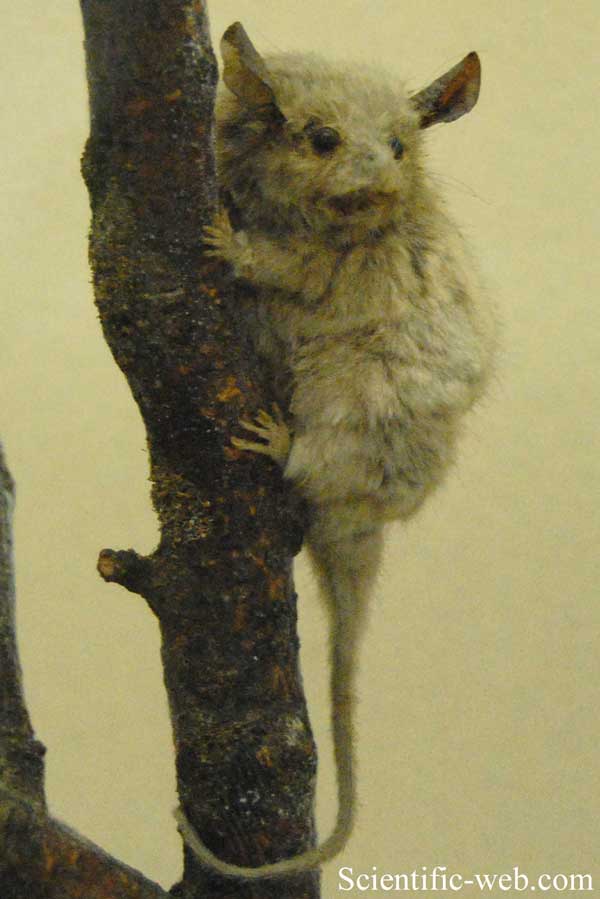Cercartetus nanus, Photo: Michael Lahanas Cladus: Eukaryota Name Cercartetus nanus (Desmarest, 1818) Type locality: Australia, Tasmania, Ile Maria Vernacular names Deutsch: Mausbeutler References * Cercartetus nanus on Mammal Species of the World. The Eastern Pygmy Possum (Cercartetus nanus) is a diprotodont marsupial of south-eastern Australia. Occurring from southern Queensland to eastern South Australia and also Tasmania,[1] it is found in a range of habitats, including rainforest, sclerophyll forest, woodland and heath. This species is very small, weighing from 15 to 43 grams and having a body length of between 70 and 110 millimetres. It is light-brown above and white below, with big, forward pointing ears and a long, almost bare, prehensile tail. The Eastern Pygmy Possum is an active climber. It uses its brush tipped tongue to feed on nectar and pollen, especially from Banksia, Eucalyptus and Callistemon species.[3] It also feeds on insects, and will eat soft fruits when flowers are not available. It is a largely solitary animal, sheltering in tree hollows and stumps, abandoned bird-nests, and thickets. During winter it spends time in torpor. The female will usually have four, but sometimes 5 young. The young will stay and nurse in her pouch for up to 6 weeks.[3]
The first specimen of Eastern Pygmy Possum known to Europeans was collected by François Péron, a naturalist aboard Nicolas Baudin’s voyage to the south seas.[4] Whilst on a short stay on Maria Island, off eastern Tasmania between 19 and 27 February 1802, Péron traded with the Aboriginal inhabitants for a single small marsupial. Péron wrote (in translation) ‘In the class of mammiferous animals, I only saw one kind of Dasyurus, which was scarcely as large as a mouse. I obtained one that was alive, in exchange for a few trifles, from a savage who was just going to kill and eat it’.[5] In an unpublished manuscript (now held in the Le Havre Museum in France) Péron also wrote that the animal ‘was given to me by the natives; it was still alive; I believe it to be a new species and have described it as Didelphis muroides because of its resemblance to the D. mus of Linnaeus’.[6] The specimen collected by Péron (a juvenile male) was transported back to France, and is now held in the Muséum National d’Historie Naturelle in Paris as the holotype.[7] Taxonomy and nomenclature The Eastern Pygmy Possum is the type species of the genus Cercartetus (family Burramyidae), and was first described as Phalangista nana with the specific name meaning ‘dwarf’ in Latin. Currently, the authority for the specific name is widely accepted as Desmarest 1818, but in a review recently published, it was pointed out that an earlier version of Desmarest's account was published in 1817.[4] Names synonymous with Cercartetus nanus are Phalangista glirifomis (Bell, 1828) and Dromicia britta (Wood Jones, 1925).[1] These coincide with the two subspecies C. n. nanus (Desmarest, 1818) (the Tasmanian subspecies) and C. n. unicolor (Krefft, 1863) (the mainland Australian subspecies).[1] Vernacular names that have been used for this species include dwarf phalanger, minute phalanger, dwarf cuscus, pigmy phalanger, Bell's Dromicia, opossum mouse, dusky Dromicia, pygmy opossum, thick-tailed Dromicia, mouse-like phalanger, common dormouse-phalanger, dormouse phalanger, common dormouse-opossum, dormouse possum, pigmy opossum, pigmy possum and eastern pigmy possum.[4] A standard name finally arose via a committee of the Australian Mammal Society.[8] Fossil record Bones of this species are often recorded as fossils or sub-fossils from late Pleistocene and Holocene cave deposits in south-eastern Australia. It is incorporated into the fossil record because owls and/or quolls that have preyed on Eastern Pygmy Possums (and other small mammals) deposit regurgitated or faecal pellets in caves which then act as excellent preservation sites. About 50 such sites form the fossil record for the Eastern Pygmy Possum.[9][10][11] Conservation status This species is listed as least concern by the IUCN,[2] and both subspecies are listed as lower risk by Australian Commonwealth Government legislation. At the State level within Australia, its status is defined variously. In New South Wales, it is considered vulnerable under the Threatened Species Conservation Act 1995. In South Australia, the species is considered vulnerable under Schedule 8 of that State's National Parks and Wildlife Act 1972. In Victoria, it is not listed under the Flora and Fauna Guarantee Act 1988, and is therefore officially not threatened. Records for Queensland are scant, but the species is perhaps misleadingly classed as common under that State's Nature Conservation (Wildlife) Regulation 1994. In Tasmania, the Eastern Pygmy Possum is currently considered not threatened under the Nature Conservation Act 2002. Predators and parasites Known predation records are by the Barn Owl Tyto alba, the Masked Owl T. novaehollandiae, the Sooty Owl T. tenebricosa, the Barking Owl Ninox connivens, the Brown Antechinus Antechinus stuartii, the Tiger Quoll Dasyurus maculatus, the Tasmanian Devil Sarcophilus harrisii, the Dingo Canis lupus dingo, the Dog Canis lupus familiaris, the Red Fox Vulpes vulpes, the Cat Felis catus, Stephen's Banded Snake Hoplocephalus stephensii, and the Rough-scaled Snake Tropidechis carinatus.[9][10][12][13] Parasites recorded for the Eastern Pygmy Possum are the fleas Acanthopsylla rothschildi, A. scintilla, Choristopsylla thomasi, and Ch. ochi; the mites Guntheria newmani, G. shieldsi, Ornithonyssus bacoti (normally a parasite of captive rats), and Stomatodex cercarteti (type described from C. nanus); two nematodes Tetrabothriostrongylus mackerrasae and Paraustrostrongylus gymnobelideus; and the common marsupial tick Ixodes tasmani. There is also a record of a free-living platyhelminth Geoplana sp., although this was possibly an accidental infection.[14] References 1. ^ a b c d Groves, C. (2005). Wilson, D. E., & Reeder, D. M, eds. ed. Mammal Species of the World (3rd ed.). Baltimore: Johns Hopkins University Press. pp. 45. ISBN 0-801-88221-4. OCLC 62265494. http://www.bucknell.edu/msw3. Source: Wikipedia, Wikispecies: All text is available under the terms of the GNU Free Documentation License |
|


